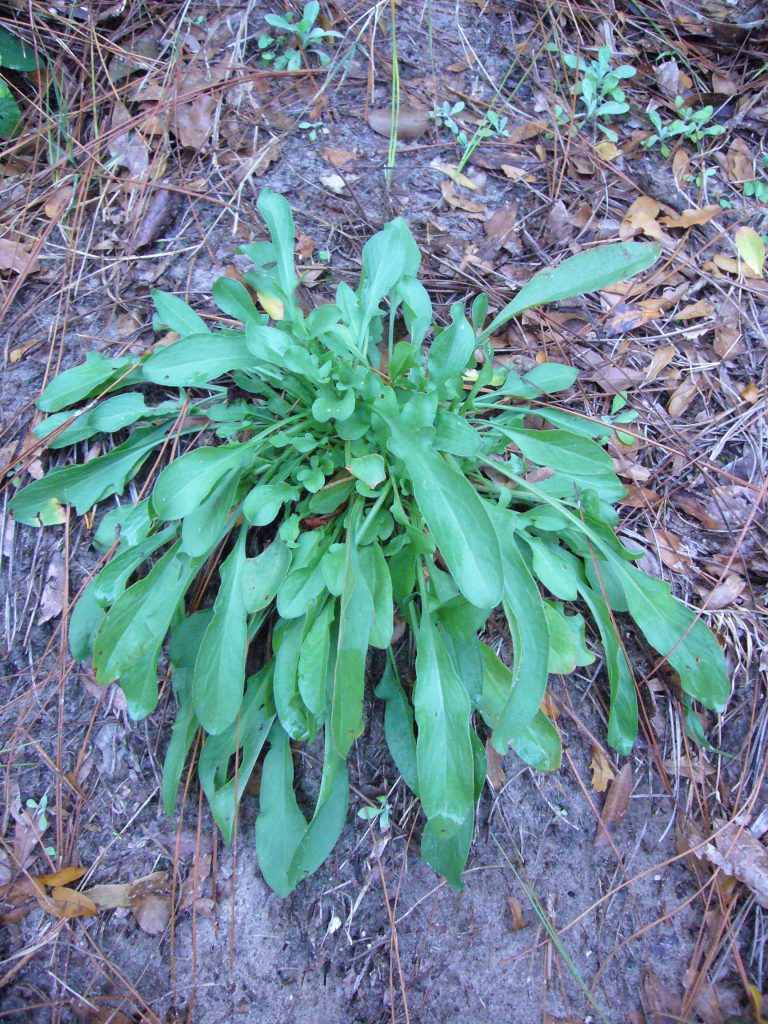
The leaves of Heartwing Dock resemble wide knives. Photo by Green Deane
Species in the Rumex genus can be difficult. No doubt you are seeing one now in many fields. Usually here this time of year it’s R. hastatulus, Heartwing Dock aka Hastateleaf Dock. R. acetosella, Sheep Sorrel, resembles it in shape and taste but is rather rare in Florida, in only two counties and not seen for a long time. Nonetheless most folks wrongly call R. hastatulus Sheep Sorrel instead of Heartwing Dock. It’s hard to fight the crowd. All parts above ground are edible but usually just leaves and seeds.
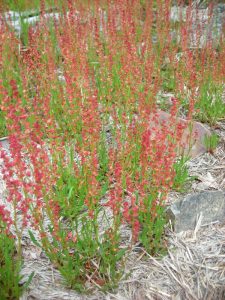
The redish-pink seeds are also edible. Photo by Green Deane
One can’t mention Rumexes without a knowing nod to Professor Merritt Fenald. He was the Big Botanist on Campus at Harvard for half a century starting around 1900. He co-wrote with Alfrd Kinsey a book on foraging around 1920 but it was not printed until 1943 when rationing was imposed during World War II. A new edition was printed 1958 (and reprinted in 1996.) At the time Fernald said there were some 15 Rumex in North America and all edible (but not all palatable.) The actual number of species and their names varies today with eleven listed in the state. Another confusing aspect is that some of them are tart when young but grow bitter when old. I think R. crispus (Curly Dock) and R. verticillatus (Swamp Dock) have that characteristic. (That is why I have found them both tart and bitter.)
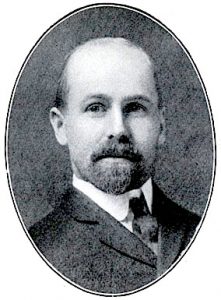
Harvard Professor Merritt Fernald.
As a curious aside I have a reasonably large book library on plants. The botanical “bible” for Florida is the Guide to the Vascular Plants of Florida (third edition, 2011) by Richard Wunderlin and Bruce F. Hansen. In that book the Rumexes are geographically described on page 566. I also have Gray’s Manual of Botany written by Fernald and copyrighted in 1950, the year Fernald died. Rumexes in that book are on page… 566. Nice coincidence. Incidentally Fernald’s book — Edible Wild Plants of Eastern North America — was printed eight years after his death by The President and Fellows of Harvard College. They also did the reprint in 1996, a century after Fernald was a student at Harvard.
You can read about the Rumexes here.
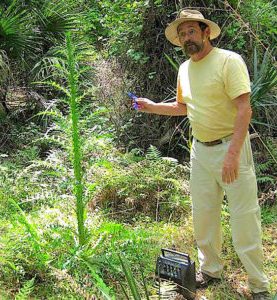
Foraging classes are held rain or shine, heat or cold. Photo by Nermina Krenata
I don’t have any foraging classes this weekend because of the Florida Herbal Conference near Lake Wales. So we start again in March. Note a class that was scheduled for Red Bug Slough has been changed to Ft. Desoto.
Saturday, March 7th, Blanchard Park, 10501 Jay Blanchard Trail, Orlando, FL 32817. 9 a.m. to noon. Meet at the pavilion near the YMCA building and tennis courts.
Sunday, March 8th, George LeStrange Preserve, 4911 Ralls Road, Fort Pierce, FL, 34981. 9 a.m. to noon. (There are no official bathrooms at this location.)
Saturday, March 14th, Florida State College, south campus, 11901 Beach Blvd., Jacksonville, 32246. We meet at Building “A” next to the administration parking lot. 9 a.m. to noon.
Sunday, March 15th, Ft. Desoto Park, 3500 Pinellas Bayway S. St. Petersburg Fl 33715. There is an entrance fee to the park as well. Meet at the bay fishing pier parking lot. It’s a large parking lot, meet near the bathrooms. We will walk a good bit. 9 a.m. to noon.
Saturday, March 21th, Ft. Meade Outdoor Recreation Area, 1639 Frostproof Highway, Fort Meade, FL 33841. (Frostproof Highway is also Route 98.) 9 a.m to noon. Meet at the second set of bathrooms (in the middle of the park) which is due south from the highway. (Don’t confuse this location with Mead Gardens which is in Winter Park near Orlando.)
Sunday, March 22nd, Wickham Park, 2500 Parkway Drive, Melbourne, FL 32935-2335. Meet at the “dog park” inside the park. 9 a.m. to noon.
Saturday, March 28th, Haulover Canal, Merritt Island National Refuge, north of the Kennedy Space Center. . Read the instructions below. We meet the the northwest end of the canal area.
Sunday, March 29th, Spruce Creek Park, 6250 Ridgewood Ave. Port Orange FL, meet at the pavilion. 9 a.m. to noon.
For more information, to sign up for a class, or to pre-pay go here.
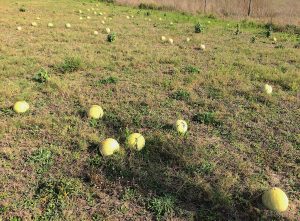
It’s easy to see where citrus used to grow. Look for the melons.
A familiar sight this time of year are left over Citron Melons descendants of cultivated citrons from centuries ago. We can see them now because tall grass — which replaced frozen-out citrus –is dry in many place and died back. But you can also find them in active citrus groves like Lamb’s Quarters. While they are “edible” usually it is only the rind that is processed in various ways. Interestingly Citron Melons came to Florida before or with the citrus industry. Depending on which expert you want to quote Floridians have been raising citrus for some 508 years or so and citrons grow faster than citrus. Steady sources of modern food made them obsolete particularly as a source of pectin. Citron Melons escaped cultivation and have been taking care of themselves ever since. When I wrote my original article about them information was hard to find and foggy… still is. You can read about them here.
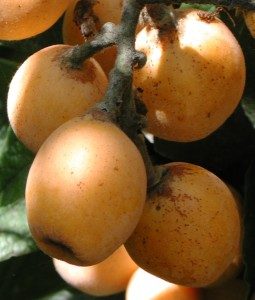
Loquats ripen from tart to sweet and can be dried like plums to prunes. Photo by Green Deane
An imported and now naturalized tree that is fruiting early is the Loquat. We ate some last week near Deland FL. The Loquat is a very common backyard fruit tree which has “liberated” itself into the statewide landscape. Most of the Loquats locally fruit in the spring but there is a variation that fruits in the fall, not common. Often it is trained into a bowl shape to increase fruit production area. Interestingly the easy-to-identify leaves have terpenes and have herbal applications. While it is commonly called the “Japanese Plum” it is not a plum nor is it from Japan. The fruit is edible from tart yellow to sweet yellow. The unripe green fruit is toxic particularly to children. It also as a small amount of arsenic in it naturally. You can read about the Loquat here.
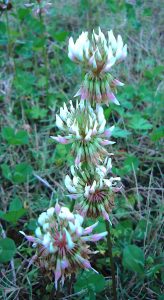
Clover can be used for tea. Photo by Green Deane
Clover is one of those wild edibles that is both overstated and understated. The overstatement is from writers who offer it as a great human food full of this and that to keep us healthy. The understated part is that it can harbor a fungus that inhibits clotting and somewhere around a half-a-cup of raw leaves can make you throw up. Individual experience, of course, can vary and there are several different species of clover with different characteristics. Pictured here is a nice little White Clover. A few leaves can be eaten raw. They are high in protein for a leaf. The blossom fresh or quickly dried can be used for tea. There is also Crimson, Red, Sweet and even Tick Clover.

Green Deane Forum
Want to identify a plant? Perhaps you’re looking for a foraging reference? You might have a UFO, an Unidentified Flowering Object, you want identified. On the Green Deane Forum we — including Green Deane and others from around the world — chat about foraging all year. And it’s not just about warm-weather plants or just North American flora. Many nations share common weeds so there’s a lot to talk. There’s also more than weeds. The reference section has information for foraging around the world. There are also articles on food preservation, forgotten skills from making bows to fermenting food. Several hard-to-find books are there page for page. Recent posts this week include Nettle Spanakopita, Pawpaws Starting Early? What are those White Blossoms, Brazilian Pepper Revisited, COVID 19, Palmer Amaranth, In The Loop, Tomatoes: A Fruit First, a Vegetable Second, and Butterweed: Annual Warning. You can join the Forum by going to the upper right hand top of this page.
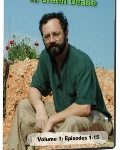
Foraging DVDs make a good gift to watch during winter.
Though your foraging may drop off during the winter it’s a great time to study wild edibles with my nine DVD set. Each DVDs has 15 videos for 135 in all. They make a great gift. Order today. Some of these videos are of better quality than my free ones on the Internet. They are the same videos but many people like to have their own copy. I burn and compile the sets myself so if you have any issues I handle them personally. There are no middle foragers. And I’m working on adding a tenth DVD. To learn more about the DVDs or to order them click here.
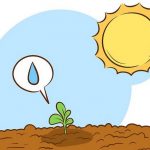 Donations to upgrade EatTheWeeds.com have gone well. Thank you to all who have contributed to either via the Go Fund Me link, the PayPal donation link or by writing to Green Deane POB 941793 Maitland FL, 32794. There are many needs left such as expanding the foraging teacher page and the page on monotypic edibles. There’s always something and such things get more complex and expensive every year.
Donations to upgrade EatTheWeeds.com have gone well. Thank you to all who have contributed to either via the Go Fund Me link, the PayPal donation link or by writing to Green Deane POB 941793 Maitland FL, 32794. There are many needs left such as expanding the foraging teacher page and the page on monotypic edibles. There’s always something and such things get more complex and expensive every year.
This is weekly newsletter 394, If you want to subscribe to this free newsletter you can find the sign-up form in the menu at the top of the page.
To donate to the Green Deane Newsletter click here.

